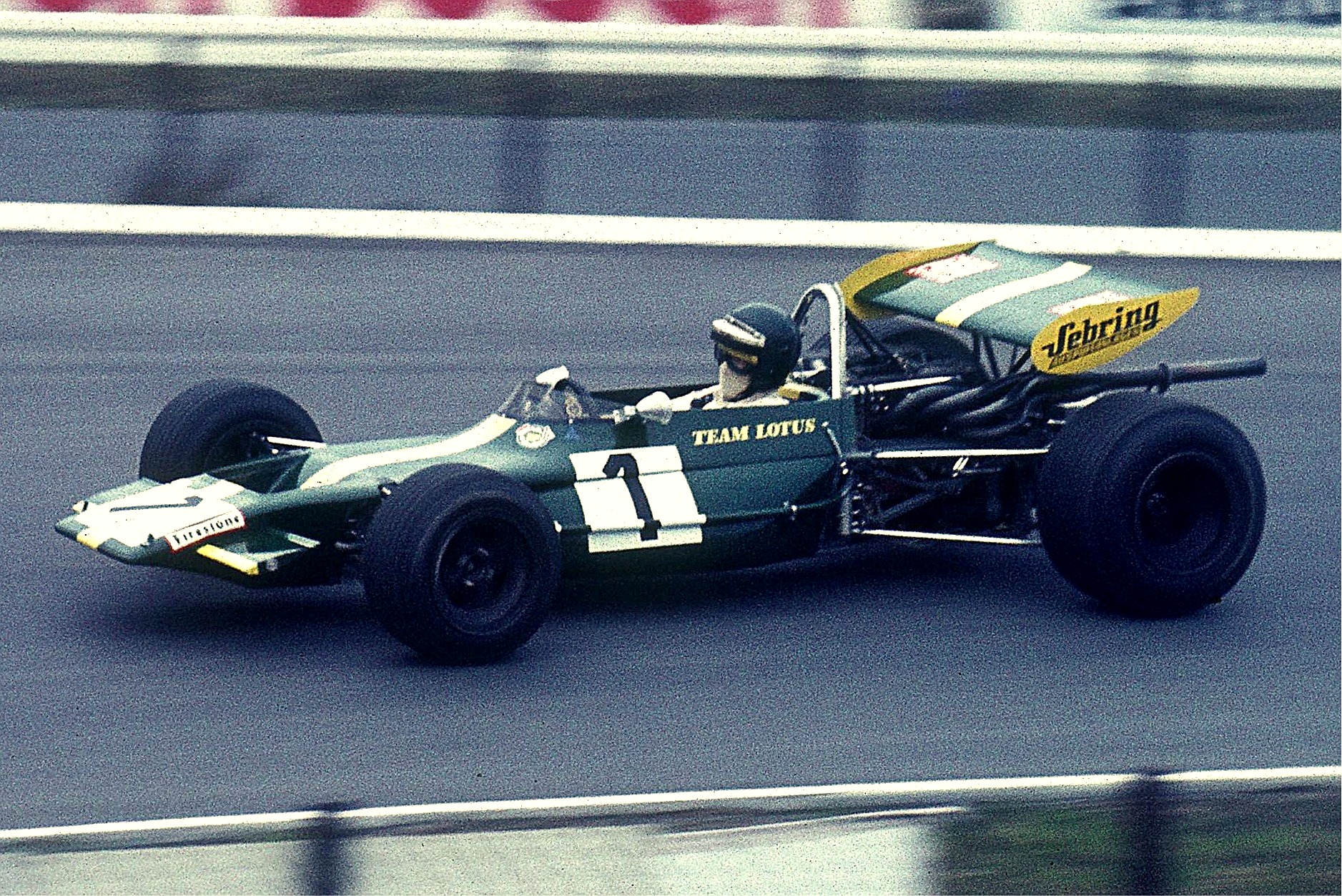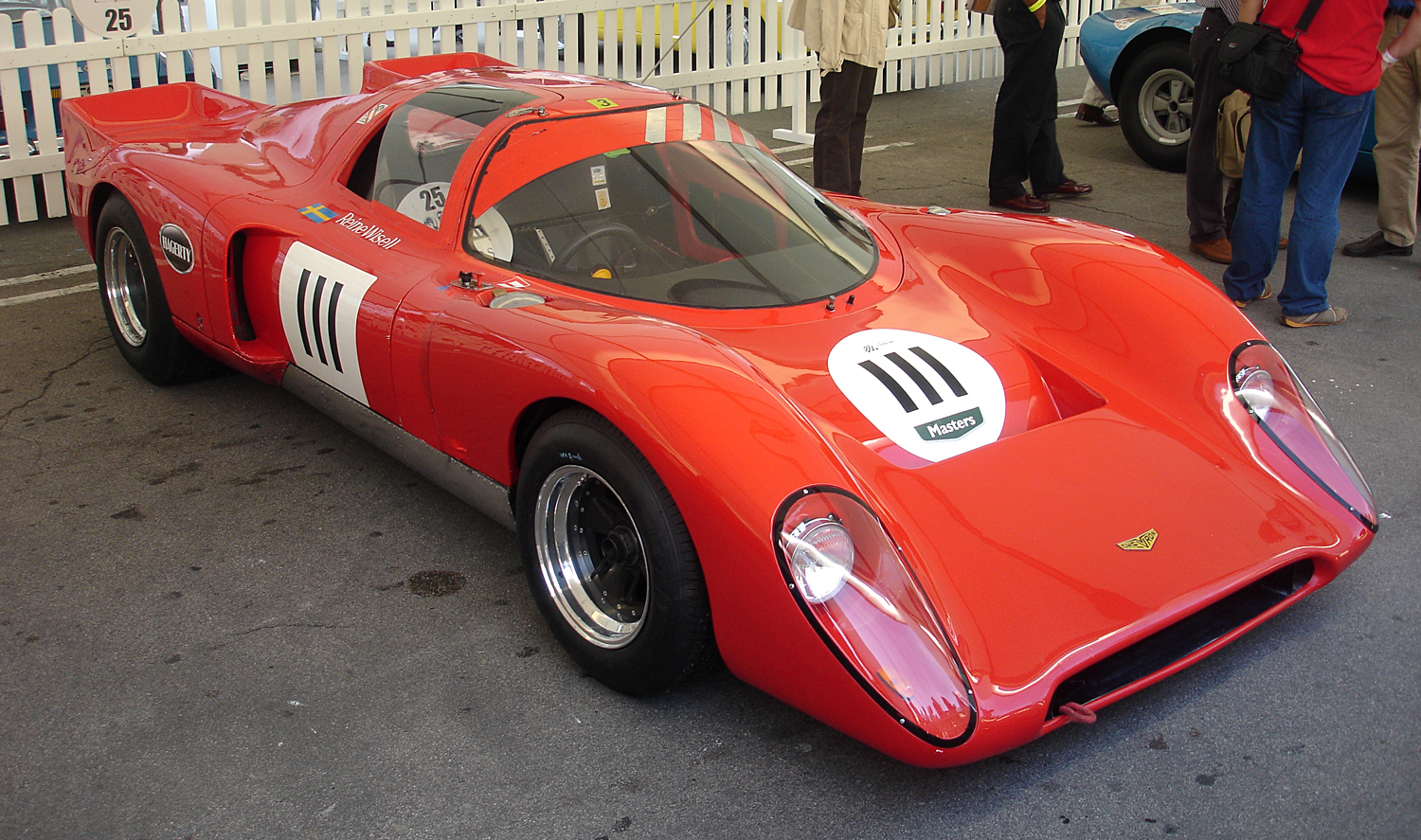|
Chevron Cars Ltd
Chevron Cars Ltd. is an English manufacturer of racing cars, founded by Derek Bennett in 1965. Following Bennett's death in 1978, the firm has remained active in various guises. The original company's designs and name continue to be used to build replacement parts and continuation models of earlier Chevrons. In 2000, Chevron Racing Cars Ltd., founded by Vin Malkie acquired the trade mark Chevron Racing Cars Ltd and in addition to the company's other activities has designed and built new grand tourer racing cars under the Chevron name, as well as other continuation models of earlier Chevrons. History Derek Bennett Derek Bennett was born in 1933 in Manchester and was brought up in Prestwich. He was a largely self-taught, intuitive engineer and a talented amateur racing driver. In his early years Bennett took a keen interest in model aircraft. He took an apprenticeship in mechanical and electrical engineering before becoming a mechanic, but he soon fell in with motor racing ... [...More Info...] [...Related Items...] OR: [Wikipedia] [Google] [Baidu] |
Chevron Corporation
Chevron Corporation is an American multinational energy corporation predominantly specializing in oil and gas. The second-largest direct descendant of Standard Oil, and originally known as the Standard Oil Company of California (shortened to Socal or CalSo), it is active in more than 180 countries. Within oil and gas, Chevron is vertically integrated and is involved in hydrocarbon exploration, production, refining, marketing and transport, chemicals manufacturing and sales, and power generation. Founded originally in Southern California during the 1870s, the company was then based for many decades in San Francisco, California, before moving its corporate offices to San Ramon, California, in 2001; on August 2, 2024, Chevron announced that it would be relocating its headquarters from California to Houston, Texas. Chevron traces its history back to the second half of the 19th century to small California-based oil companies which were acquired by Standard and merged into St ... [...More Info...] [...Related Items...] OR: [Wikipedia] [Google] [Baidu] |
Formula Two
Formula Two (F2) is a type of Open-wheel car, open-wheel formula racing category first codified in 1948. It was replaced in 1985 by Formula 3000, but revived by the FIA from 2009 FIA Formula Two Championship season, 2009 to 2012 FIA Formula Two Championship season, 2012 in the form of the FIA Formula Two Championship (2009–2012), FIA Formula Two Championship. The name returned again in 2017 when the former GP2 Series became known as the FIA Formula 2 Championship. History While Formula One has generally been regarded as the pinnacle of open-wheeled auto racing, the high-performance nature of the cars and the expense involved in the series has always meant a need for a path to reach this peak. For much of the history of Formula One, Formula Two has represented the penultimate step on the motorsport ladder. Pre-war Prior to the Second World War, there usually existed a division of racing for cars smaller and less powerful than Grand Prix racers. This category was usually cal ... [...More Info...] [...Related Items...] OR: [Wikipedia] [Google] [Baidu] |
Chevron B26
The Chevron B26 is a 2-liter Group 6 sports prototype race car, designed, developed and built by British manufacturer Chevron, in 1973. Over its racing career, spanning 14 years, it won a total of 17 race wins (including 17 additional class wins), achieved 43 podium finishes, and clinched 9 pole positions. It was powered by a naturally-aspirated A naturally aspirated engine, also known as a normally aspirated engine, and abbreviated to N/A or NA, is an internal combustion engine in which air intake depends solely on atmospheric pressure and does not have forced induction through a turboc ... Hart 420R four-cylinder engine, developing . References {{reflist Chevron racing cars Sports prototypes 24 Hours of Le Mans race cars Sports racing cars ... [...More Info...] [...Related Items...] OR: [Wikipedia] [Google] [Baidu] |
Chevron B23
The Chevron B23 is a Group 5 (racing), Group 5 sports prototype race car, designed, developed and built by British manufacturer Chevron Cars Ltd, Chevron, in 1973. Over its racing career, spanning 12 years, it won a total of 12 races (plus 15 additional class wins), scored 41 podium finishes, and clinched 2 pole positions. It was powered by a naturally-aspirated Ford Motor Company, Ford-Cosworth DFV Formula One engine, producing . References {{reflist Chevron racing cars Sports prototypes 24 Hours of Le Mans race cars Sports racing cars ... [...More Info...] [...Related Items...] OR: [Wikipedia] [Google] [Baidu] |
Chevron B21
The Chevron B21 is a 2-liter Group 5 sports prototype race car, designed, developed and built by British manufacturer Chevron, in 1972. Over its racing career, spanning 13 years, it won a total of 23 races (as well as 15 additional class wins), scored 45 podium finishes, and clinched 11 pole positions. It was powered by a naturally-aspirated A naturally aspirated engine, also known as a normally aspirated engine, and abbreviated to N/A or NA, is an internal combustion engine in which air intake depends solely on atmospheric pressure and does not have forced induction through a turboc ... Ford- Cosworth BDG, or BMW M12/7, four-cylinder engine, both making around . Only 28 cars were built. References {{reflist Chevron racing cars Sports prototypes 24 Hours of Le Mans race cars Sports racing cars ... [...More Info...] [...Related Items...] OR: [Wikipedia] [Google] [Baidu] |
Chevron B19
The Chevron B19 is a 2-liter sports prototype race car, designed, developed and built by British manufacturer Chevron Cars Ltd, Chevron in 1971. Only 35 cars were built. References {{reflist Chevron racing cars Sports prototypes 24 Hours of Le Mans race cars Sports racing cars ... [...More Info...] [...Related Items...] OR: [Wikipedia] [Google] [Baidu] |
Porsche 908
The Porsche 908 was a racing car from Porsche, introduced in 1968 to continue the Porsche 906- Porsche 910- Porsche 907 series of models designed by Helmuth Bott (chassis) and Hans Mezger (engine) under the leadership of racing chief Ferdinand Piëch. As the FIA had announced rule changes for Group 6 prototype-sports cars limiting engine displacement to 3,000 cc, as in Formula One, Porsche designed the 908 as the first Porsche sports car to have an engine with the maximum size allowed. The previous Porsche 907 only had a 2,200 cc Type 771/1 flat-eight engine developing . The new 3-litre Type 908 flat-eight produced at 8,400 rpm. Being traditionally air-cooled and with only two valves per cylinder, it still had less power compared to more modern F1 designs which delivered over , but were not suited to endurance racing. The 908 originally was a closed coupe to provide low drag at fast tracks, but from 1969 on was mainly raced as the 908/2, a lighter open spyder. A more comp ... [...More Info...] [...Related Items...] OR: [Wikipedia] [Google] [Baidu] |
Abarth
Abarth & C. S.p.A. () is an Italian racing- and road-car maker and performance division founded by Italo-Austrian Carlo Abarth in 1949. Abarth & C. S.p.A. is owned by Stellantis through its Italian subsidiary. Abarth's logo is a shield with a stylized scorpion on a yellow and red background, a short, wide Italian flag in the middle, and "Abarth" text on a black background. History 1949: Abarth & C. Carlo Abarth was sporting director of the Cisitalia racing team starting in 1947. The following year, the manufacturer folded, and founder Piero Dusio flew to Argentina. Abarth, funded by Armando Scagliarini, took over Cisitalia's assets and on 31 March 1949, Abarth & C. was founded in Bologna. Carlo's astrological sign, Scorpio, was chosen as the company logo. From the Cisitalia liquidation, Abarth obtained five 204 sports cars (two complete Spiders and three unfinished), a D46 single-seater, and various spares. The Cisitalia 204s were immediately rechristened Abarth Cisit ... [...More Info...] [...Related Items...] OR: [Wikipedia] [Google] [Baidu] |
Brian Redman
Brian Herman Thomas Redman (born 9 March 1937) is a British retired racing driver. Racing for Carl Haas and Jim Hall's Chaparral Cars, Brian Redman won the 1974, '75 and '76 SCCA Formula 5000 series and has raced in nearly every category of racing, including Formula One. The Englishman began racing in 1959 and collected his first of four Manufacturers Championships in 1968, driving a Ford GT40 with Belgian Jacky Ickx for John Wyer Automotive Engineering. Redman also won the 1970/71 South African Springbok series and the IMSA Camel GTP Championship in 1981 driving a Lola T600. Brian is considered to be one of the greatest endurance racers in the history of the sport. In addition to his four victories at Spa-Francorchamps, Brian has overall wins in the 1970 Targa Florio, the Watkins Glen 6 Hours, the 12 Hours of Sebring twice, the Nurburgring 1000 Ks twice, Brands Hatch 6 Hours twice, Osterrechring 1000 Ks twice, Monza 1000 Ks twice, Kyalami 9 Hours twice, has been a two-ti ... [...More Info...] [...Related Items...] OR: [Wikipedia] [Google] [Baidu] |
Ford Motor Company
Ford Motor Company (commonly known as Ford) is an American multinational corporation, multinational automobile manufacturer headquartered in Dearborn, Michigan, United States. It was founded by Henry Ford and incorporated on June 16, 1903. The company sells automobiles and commercial vehicles under the List of Ford vehicles, Ford brand, and luxury cars under its Lincoln Motor Company, Lincoln brand. The company is listed on the New York Stock Exchange under the single-letter ticker symbol F and is controlled by the Ford family (Michigan), Ford family. They have minority ownership but a plurality of the voting power. Ford introduced methods for large-scale manufacturing of cars and large-scale management of an industrial workforce using elaborately engineered manufacturing sequences typified by moving assembly lines. By 1914, these methods were known around the world as Fordism. Ford's former British subsidiaries Jaguar Cars, Jaguar and Land Rover, acquired in 1989 and 2000, r ... [...More Info...] [...Related Items...] OR: [Wikipedia] [Google] [Baidu] |
Grand Tourer
A grand tourer (GT) is a type of car that is designed for high speed and long-distance driving with performance and luxury. The most common format is a Front-engine, rear-wheel-drive layout, front-engine, rear-wheel-drive two-door coupé with either a two-seat or a 2+2 (car body style), 2+2 arrangement. Grand tourers are often the coupé derivative of Luxury vehicle, luxury saloon (car), saloons or sedans. Some models, such as the Ferrari 250 GT, Jaguar E-Type, and Aston Martin DB5, are considered classic examples of ''gran turismo'' cars. The term is a near-calque from the Italian language phrase ''gran turismo'', which became popular in the English language in the 1950s, evolving from fast touring cars and Streamliner, streamlined closed sports cars during the 1930s. Origin in Europe The grand touring car concept originated in Europe in the early 1950s, especially with the 1951 introduction of the Lancia Aurelia, Lancia Aurelia B20 GT, and features notable luminaries of Ital ... [...More Info...] [...Related Items...] OR: [Wikipedia] [Google] [Baidu] |
Chevron B16
The Chevron B16 was a Group 4 (racing), Group 4 sports prototype race car, designed, developed, and built in 1969 by the British racing car manufacturer Chevron Cars Ltd, Chevron Cars as a two-seater racing sports car for the makes world championship. Brian Redman won the very first outing, the race at the Nürburgring on September 7, 1969, at a time of 3:13:01.6 hours. The last victory with a Chevron B16 was achieved by Clemens Schickentanz on July 11, 1971, in the sports car race at the Norisring. Design and versions As with the previous Chevron B8, B8, Derek Bennett (1933–1978) used a lattice tube construction with stiffening sheets of steel and aluminum for the chassis. The chassis with double wishbones on all wheels corresponded to the usual. Derek Bennett also designed the fiberglass body, which was manufactured by Specialized Moldings. The first cars were powered by a 1.6 liter Ford Cosworth FVA engine from Formula 2. Thanks to personal contact between Bennett and Keith ... [...More Info...] [...Related Items...] OR: [Wikipedia] [Google] [Baidu] |






